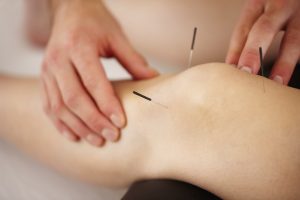Article prepared by Jim Burke
There would not be many of you out there who have not heard of acupuncture.  Acupuncture is a traditional Chinese medicine technique that has been around for over a thousand years. It involves insertion of fine needles into specific points in the body in order to elicit a number of possible positive health benefits. Over the past few years dry needling is a term and technique that has been increasingly used. Dry needling involves the insertion of fine acupuncture needles into distinct areas in muscles, known as trigger points, in order to provide pain relief and improved muscle function.
Acupuncture is a traditional Chinese medicine technique that has been around for over a thousand years. It involves insertion of fine needles into specific points in the body in order to elicit a number of possible positive health benefits. Over the past few years dry needling is a term and technique that has been increasingly used. Dry needling involves the insertion of fine acupuncture needles into distinct areas in muscles, known as trigger points, in order to provide pain relief and improved muscle function.
So what is the difference between acupuncture and dry needling?
Basically this comes down to the philosophy behind the points which are used as well as the proposed dysfunctions which are able to be treated.
Acupuncture is based on traditional Chinese beliefs that Chi (life energy) flows through a system of channels or meridians in the body. When Chi becomes stagnant or the flow is disrupted, illness and disease result. In order to restore the flow of Chi, needles are inserted into distinct points along the meridian. Acupuncture claims to be able to treat a wide range of both musculoskeletal as well as more visceral ailments. The points selected are based on their proposed effect on the dysfunctional body systems in question as well as assessment to guide where in the meridians a blockage may be occurring.
Dry Needling utilises a more western approach, involving inserting the needles into trigger points in muscles in order to release the painful trigger point and restore the function of the muscle. Trigger points occur in distinct areas in each muscle and are activated by injury, overuse or stress to the muscle. When activated, these points become tight painful ‘knots’ or bands within the muscle, which are very sensitive to mechanical pressure and have been shown to decrease the peak power output, co-ordination and endurance of the muscle in question. It has been shown that by inserting an acupuncture needle into these points, you are able to get a reflex relaxation of the trigger point, restoring muscle function and reducing pain. Dry needling tends to be used to treat pain and injury and does not claim to be able to treat visceral ailments such as allergy, gastrointestinal issues or depression.
So which treatment is the right one?
It is important to note that acupuncture is a very ancient treatment modality and much of the language used to describe its effects was developed many years ago, without the benefit of modern medical research. While research has determined that energetic pathways or meridians do not exist in the body, it is interesting to note that most acupuncture points actually correspond with nerves, motor or trigger points in muscles and may elicit their effects through this pathway. It appears likely that when discussing injury and pain, both acupuncture and dry needling both tend to work on the same systems in the body to achieve their effect while the description of how they are working as well as rationale for choosing the individual points to use may vary.
